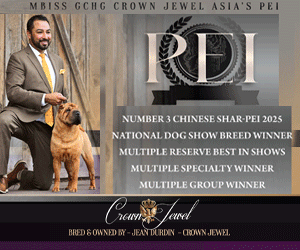Glen Iris Pekingese
Click here to read the complete article
118 – February, 2015
By Amy Fernandez
Dorothy Franc’s multifaceted contributions to America’s dog world are largely forgotten. Matronly widows are generally not famed for initiative, originality and groundbreaking accomplishments. In many respects, she was ahead of her time. Unconventional, misunderstood, and impossible to pigeonhole, most breed historians have therefore overlooked her role in Pekingese history. That wasn’t difficult. Unlike most successful fanciers, she never indulged in self-promotion.
Founded in 1917, her Glen Iris bloodline achieved national prominence in 1924 when Ch. Glen Iris Dai Dream won the first Toy Group ever offered at Westminster. Two years later, AKC Gazette editor Arthur Frederick Jones visited her kennel. His first surprise was the lack of grand kennel facilities, then a standard requirement for major league competitors. Most big winners heralded from massive breeding operations that featured multiple kennel buildings sprawling over several acres, managed by legions of handlers, trainers, and groomers. In contrast, the celebrated Glen Iris kennel was a one man operation, based on the back porch of Franc’s unassuming home in Sheepshead Bay, Brooklyn. This was just one of many eccentricities that made her an unlikely candidate for stellar success in the dog game.
No aspect of America’s Pekingese world could be termed small or modest in the 1920s. The breed glittered with dazzling names like John Pierpont Morgan, August Belmont, and James Gordon Bennett. According to George Bindley Davidson’s 1957 Pekingese Manual, “The Pekingese was truly the dog of the millionaires!”
Few breeds have enjoyed the uninterrupted popularity that’s sustained Pekingese progress since it debuted in Britain in 1860. First shown in 1894 and Kennel Club-recognized in 1898, its blueblood promoters instantly christened it the penultimate status symbol. That glossy image was reinforced when it arrived in America two years later, as Davidson confirms, “Like their English counterparts, almost all were gifts from the Dowager Empress Regent, to Americans who had done service to her empire…. She illustrated her diplomatic brilliance by giving them to such prominent people as the elder J. Pierpont Morgan, who was to sponsor the P.C.A.” These charming tokens of appreciation ensured the breed’s bluechip credentials. According to historian Dorothy Quigley’s 1970 book, “Exhibitors at early specialties read like the New York social register.” When they decided to showcase their treasured pets to the dog world, they did it with style.
The inaugural Pekingese Club of America specialty held on January 18, 1911 at the Plaza Hotel epitomized the opulence and formality that pervaded the Pekingese fancy. The judge, PCA founder Mrs. Benjamin Guinness, wore a formal gown. As she sat in the center of a ring adorned with Chinese silks and priceless bronze Fu dogs, exhibitors carried 95 Pekes before her for personal inspection. Rather than premium lists, PCA members received deckle-edged engraved invitations to upcoming specialties. Show catalogs were luxuriously printed, profusely illustrated keepsakes.
Nothing emphasized the PCA’s staggering wealth more than the stunning array of sterling silver trophies displayed at specialties. Donated by financial titans like J.P. Morgan and Gordon Bennett, their appraised value ranged from $1000-$1500 a century ago; even that seems extravagant. However, their current value would actually range from $25, 000 to $35,000. And PCA didn’t have one or two, as club secretary Iris de la Torre Bueno emphasized in her overview of club history, “It used to take a couple of hours after the regular judging to award the Pekingese Club’s specialty show trophies.”
Franc’s decision to limit her breeding program had nothing to do with her financial situation. In that respect, she was definitely one of the crowd. The Franc’s had amassed multiple fortunes in real estate, beginning with the spectacular development of Sheepshead Bay as New York’s Gold Coast, during the 1890s. Their last property investment, the Glen Iris Adirondack Resort, capitalized on the latest trendy vacation retreat for East Coast elites. It advertised modern lakefront bungalows with running water and electric lights, a private beach, and all the usual summertime entertainments like tennis, swimming, golf, and boating. Guests at Glen Iris were also treated to an extra attraction, the resident pack of Pekingese. Franc had no intention of leaving her dogs in the hands of kennel help. Each May, they were packed into traveling baskets for the 200 mile drive to “America’s Switzerland”.
Jones explained that Franc received her first Pekingese as a gift, “She had known something about the dogs before but in that year her Japanese butler induced her to accept a puppy from his litter, whelped at Glen Iris, that was the start.” The pup became top producing Ch. Glen Iris Iyo Jen. Like most breeders, Franc never envisioned the outcome when she acquired her first beloved pet. “It was purely a hobby with Mrs. Franc, right from the beginning, but after the loss of her husband it became her salvation.” She wasn’t the first person to escape from grief through work. After Sydney Franc suddenly died at age 54 in 1921, she took over the management of their Glen Iris Adirondack resort, but that wasn’t enough. “To ease the pain of his passing, she took part in more and more of dogdom’s ventures.” Her interest in Pekingese was transformed into passionate devotion. “At Glen Iris the opinion is likely to be that nothing is too much trouble. If anything is worth doing, it is worth doing to the best of your ability. That system has always ruled Mrs. Franc’s kennel of prize Pekingese and her business enterprises… that is why Glen Iris has scored such a meteoric success in the world of dogs.”
He wasn’t exaggerating. In less than a decade, she reached the pinnacle, despite her lack of background and experience. Her former partner in the project, her Japanese butler, was barred from returning to the U.S. after visiting his family. By then, she knew the basics of care and conditioning. Jones was stunned to discover that she personally handled every aspect of kennel work from whelping puppies to scrubbing crates.
“Owning a kennel was not a ‘hobby by proxy’ for she liked nothing better than taking care of her dogs. Working for them was part of being a breeder and exhibitor.”
Although that’s typical for breeders today, it wasn’t in 1926. Almost every detail of this hobby was relegated to paid professionals. Franc’s unorthodox approach definitely set her apart from most of her contemporaries who often had no direct contact with their dogs. However, it yielded multiple advantages -like the assurance that things were done right. Franc was fanatical about cleaning and disinfecting to prevent distemper and fleas. Her germophobia was justified. Distemper posed an ongoing threat at that time. For instance, in September 1934 the PCA Gazette column reported that the most famous Pekingese kennel of that era, Orchard Hill, had inadvertently picked up distemper at Morris and Essex. “Of the 30 dogs who took the contagion, one third are dead. There is nothing more heartbreaking than the plague of distemper; to work over the dogs night and day for weeks; and then stand by helpless, as the disease takes them one by one despite our best efforts….All of us who have been in the game for a number of years have gone through this once, if not more times.”
Although distemper was universally feared, the mechanics of the disease were poorly understood. Vaccinations were a novelty and would not be perfected for decades. Some were commercially available, but they were unreliable, difficult to administer, and far too costly for most owners. Most efforts focused on prevention. Suspected causes and contributors included practically everything; heat, cold, excessive or insufficient exercise, and almost every dietary component.
Franc took no chances. She obsessively protected her dogs from drafts. Their sleeping crates were raised off the floor and fitted with heavy curtains during winter.
Their diet was constantly varied, and supplemented with garlic and vitamins. Each day all bedding was laundered and sanitized and the entire kennel room disinfected from top to bottom. Every three months it was repainted. Her routine seemed excessive, but Glen Iris ranked among the very few kennels never hit by distemper. “In combating the scourge of distemper, Mrs. Franc seems to have discovered an effective system. Her dogs are benched at many shows throughout the country.” It was an acknowledged fact that the era’s lengthy benched shows were a hotbed of contagion. Every dog was examined by the show vet before entering the venue, but many infected animals were asymptomatic, a factor that made distemper such an insidious disease.
After returning from shows, Franc dipped each dog’s feet in disinfectant before they returned to her kennel. New arrivals were also a prime source of disease transmission. Many top kennels dealt with this issue by refusing outside stud service. It minimized risk – and drastically curtailed the potential contribution of valuable dogs. Franc understood the big picture, and her commitment to her breed’s overall success. Jones confirmed that bitches came to Glen Iris from every part of the country. “At the present time, her stud calendar is made up six months in advance… Mrs. Franc requires a complete physical examination by a reputable veterinarian for all matrons visiting the kennel for stud service.” As an extra precaution, they spent a few days in her backyard quarantine kennel before the mating.
She did her own mating and whelping. Even Jones acknowledged those inherent challenges. “The breeding of Pekes is always more or less of a problem…but all such obstacles can be overcome by sensible methods and constant vigilance.” Her puppies were whelped in her bedroom and raised as housepets. Admitting that Pekes were notoriously temperamental, Jones said, “The Franc dogs show very well due to training they receive from the time they are four-months-old.” Table training and basic obedience was supplemented with comprehensive socialization provided by regular walks around her Brooklyn neighborhood. “Behind those trophies lies a tale of unending care and thoughtful research.”
By 1926 Franc was in a position to capitalize on her investment but, “She refuses to commercialize her kennel…Possibly the fact that she will not breed dogs for the money is why she has been so successful.” From the time that Pekingese were recognized, they ranked among AKC’s top ten breeds. The temptations of profit remained an ongoing threat to breed integrity. “She wholeheartedly despises those people who breed anything they get their hands on and then sell the result to the Pekingese fancy as excellent specimens…a number of people have come to her asking for anything carrying the Glen Iris prefix. And she turns down such requests quite definitely.” To emphasize the point he added, “She has four dogs in her kennel now for which she has turned down offers of $5000 each.” Her approach reflects current ethical breeding practices. But that concept wasn’t even on the radar back then. As a rule, kennel managers, not owners, handled business details like selling show prospects and placing pet stock. Franc not only turned down lucrative offers, she devoted inordinate time and effort to rehome her retired dogs.
For her, this work was therapeutic. But it also gave her a rare advantage over her competitors; she spent enough time with her dogs to understand them. She knew their faults and virtues and didn’t need to rely on expert advice to design a successful breeding program. That alone was an exceptional endeavor in America’s blossoming Pekingese fancy. Numerous high profile kennels campaigned big winners, but the lasting influence of those dogs was negligible. Franc’s singular contribution became even more apparent in retrospect, which Jones stressed in his 1962 overview of Glen Iris. “Breed development meant little to them and when they stopped winning the so-called ‘big ones’ quietly disappeared from dog show circles.”
Escalating competition among American fanciers led to frenzied shopping trips rather than industrious breeding. While Franc prepared for major shows by conditioning her champions and training her puppies, her competitors frantically conducted clandestine negotiations to purchase the most famous British champions. Davidson and others noted that this had an overwhelming impact on breed development. “In the twenties more and more top winning English Pekingese were exported to the U.S. where they attained top honors and did much to dictate American type…Little attention was paid to breeding and it remained in the hands of the English to provide America with serious breeding stock.”
From the start, British supremacy directed every facet of America’s Pekingese fancy.
In 1906, the year AKC recognized the breed, Mrs. Morris Mandy arrived from England with her Thirlesmere dogs to found the first major American kennel, Downshire. That year she also organized the first Pekingese specialty. Her BOB winner, T’sang of Downshire, later became the breed’s first AKC champion. Three years later Mandy helped to found PCA and served as its first president. Needless to say, the club adopted the British standard verbatim.
In her April 1932 Gazette column, PCA secretary Iris de la Torre Bueno warned against this shortsighted attitude. “So much has been said in favor of the imported dog that the American-bred is losing out in consequence. Pekingese are far too well established on this side of the Atlantic for anyone to foster the impression that the word imported makes a dog superior. I do not mean to undermine imported dogs for we have some very fine ones in our midst. However, the mere fact that a dog is imported appears to prejudice many fanciers and judges in a dog’s favor. For many years, we have had the world’s best bloodlines in the U.S. and we have devoted breeders as well who have stuck to the game for the thrill of bettering the breed.” She cited Glen Iris as the prime example, calling Franc “a true champion of the American-bred ”.
Franc not only forged a bloodline. More remarkably, she never relied on imports. Her foundation studs, Ch. Glen Iris Iyo Jen and Ch. Chu Jen of Toddington, traced back to Downshire through the Nowata line. Its founder, Mrs. Harby, traveled frequently to England to purchase new stock. Franc subsequently acquired one of them, Ch. Chu Jen of Toddington. Harby showed him to his American title and he became a Nowata headliner despite his massive size and coarseness. Those faults were offset by his unparalleled showmanship and ring presence, traits that he also transmitted to his progeny.
Ch. Nowata Chun of Egham was considered Harby’s most significant import. His rich red color and coal black mask accentuated his gorgeous head. His overall excellent type and balance was wrapped in a perfect seven pound package. His grandson, Ch. Glen Iris Iyo Jen, confirmed his far reaching influence. An Iyo Jen son, Ch. Glen Iris Dai-Due, became the first of many Glen Iris homebred champions. She finished at the 1919 PCA specialty at 15 months of age. “Since that time the progeny of Ch. Glen Iris Iyo Jen have made themselves worth their weight in gold.” Jones wasn’t exaggerating. Iyo Jen’s most famous offspring, Ch. Glen Iris Dai Dream, and his litter sister, Ch. Glen Iris Dai-Glo, were whelped the following year, on August 15, 1920. Both finished on the same day after three months of showing. Dai Dream went on to pave the way for Pekingese supremacy of the Westminster Toy Group.
Many successful American kennels emerged in subsequent decades, but Franc was the first to stake a claim for homegrown stock. Glen Iris stands as the groundbreaking American Pekingese bloodline. In his kennel profile Jones said, “After acquiring her foundation studs she never again imported a stud dog or sought service outside her original bloodline…A keen student of genetics she linebred and inbred, procuring an occasional top bitch for outcrossing.”
For decades she remained a loner in that respect. Britain’s 40 year head start in the breed gave imports a substantial advantage. They didn’t come cheap, and these transactions carried all the familiar pitfalls of a seller’s market. Despite those drawbacks, American fanciers contentedly relied on this source for big winners. Consequently, an unshakable stigma undermined perceptions of American stock, regardless of its quality. The intrepid Iris de la Torre Bueno highlighted this troubling situation in her November 1935 Gazette column, reprinting a recent letter from a fellow PCA member.
“Miss Judith Connell has just returned from her trip abroad. She writes:
We spent three months in England visiting 22 famous kennels …we were very disappointed not to find more really outstanding dogs. There are plenty of good ones, but only one very beautiful dog, good enough to beat those over here, Ch. Fieh Chuan of Sherhill. We saw him win his 19th CC at Brighton and he comes as near being a perfect Pekingese as anything we’ve ever seen. There is nothing in England to equal him.
There seems to be no really outstanding bitch being shown. The thing that struck me was the absolute ignorance of our dogs and the belief among English breeders that Americans will buy anything and don’t know good dogs. We were shown, over and over again, dogs and puppies at various kennels that their owners thought beautiful, and they were much worse than dogs being bred over here. At Brighton someone asked me if we had any good dogs in America! I told her that our country was full of really outstanding dogs!
We are certainly breeding as good dogs in America as are being bred in England and England has little to offer now that can compete against the dogs over here. The English will never believe that because they know so little of the American-bred dogs that are coming out and winning.”
Needless to say, this occurred more than a decade after the homebred Ch. Glen Iris Dai Dream became the first Westminster Toy Group winner.
Eventually PCA acknowledged the damaging impact of this obsession with imports. The trend showed no sign of abating and the fallout was becoming impossible to ignore. Although boatloads of top quality dogs came over and won, many of them never contributed to the American gene pool. Moreover, this pervasive prejudice discouraged breeders from competing at PCA specialties. They rightly concluded that it was a pointless endeavor. In 1934, the PCA board voted to restrict entries to American-bred dogs at their annual New York specialty. The following year, exhibitors responded with an unprecedented entry of 123 for PCA vice-president Mrs. James Austin. Franc must have felt vindicated, but she was on to new projects by that time.
In September 1933 the Gazette announced, “It will be of great interest to learn that the Progressive Dog Club which has been formed in the interest of toy dogs only will hold its first affair on November 19 at the Hotel Pennsylvania. This will be a new and unique event.” Terriers and Gundogs had long enjoyed the advantages of group shows. Meanwhile, Toy breeds became a mainstay of all breed shows, consistently attracting sizeable entries, paying spectators – and second class treatment. Although Pekingese did well in all breed competition, they were the exception. The inherent disadvantages Toys faced became glaringly evident after AKC instituted group and Best In Show competition.
The Toy breed show wasn’t a new concept, but past events were invariably treated as amateurish, unprofessional affairs that reinforced the preexisting disregard for these breeds. Franc was determined to reinvent this idea and showcase individual breeds before prominent experts. It was unprecedented.
Progressive’s inaugural event met with AKC indifference and fancier skepticism. Every breed was represented but the entry of 92 Pekingese kept the ship afloat. BIS went to Ch. Han Chuan of Orchard Hill. Winners Bitch went to Glen Iris Dai Star Patti, the eighth generation of Franc’s breeding. In January 1934 the PCA Gazette column called it a triumph. “Much of the success of this show was due to the immense amount of work done by the club president. Mrs. S. Franc. Her efforts were by no means in vain, as all who attended and many more besides, are looking forward to the next Progressive Dog Club Show.”
Founding a group club like Progressive Dog Club during the Great Depression added another element of risk to this dubious proposition. During those years, overall entries plummeted and established AKC clubs sank like leaky rowboats. No one expected it to last, but Dorothy Franc understood breeders. Although Pekingese entries dominated at first, breeders wholeheartedly supported this unique opportunity. Every Toy breed soon drew respectable entries, often surpassing all breed shows during those years.
By 1939 Progressive’s viability was assured. The entry topped 239 and even the dog world’s most caustic critic, Arthur Frederick Jones, conceded, “because this year’s show proved to be such an outstanding success in the number and quality of dogs put on the benches, it is expected that the Progressive club will keep moving on to new records.”
Franc died the following year.
Two years later, in December 1941, as America prepared to enter World War II, Jones reported on the club’s ninth successful show. And even he had to admit that Toy breeds had now established their credibility in America’s dog world. “With an exceptionally high level of quality prevailing throughout the 235 entries of 15 breeds at the annual Progressive Dog Club show in the Hotel Pennsylvania on November 9, and with the largest paid attendance in the club’s history, this year’s all Toy show takes rank as the best of its kind. Its success is a tribute to the relentless effort expended upon details of organization by the club’s president. Seen about the judging ring were many notables from other breeds and also many officials from many other show giving organizations. Among the spectators was Dudley Rogers, president of AKC….Satisfaction with the judging was very evident. The memory of the late Mrs. Sydney Franc, founder of the club and its president for many years, was honored during the program by a period of silence.”
Dorothy Franc may be a dim memory but she left a powerful legacy, helping to establish the credibility of American-bred Pekingese and Toy breeds in general. She didn’t expect accolades, as Jones noted, “It was the love of her dogs that set everything in motion.”
A Truly Ancient Breed
DNA evidence has confirmed the Pekingese as one the 14 most ancient breeds. Corroborating documentation reveals that small, short-mouth dogs existed in China for at least 1000 years. However, it is impossible to pinpoint precisely when the Pekingese emerged as a distinct breed. The name “Pekingese” probably didn’t come into use in China much earlier than the seventeenth century.
Short URL: http://caninechronicle.com/?p=70359
Comments are closed












